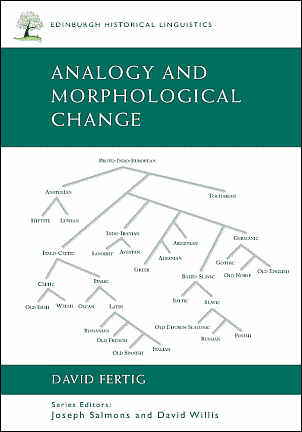言語変化の説明原理の1つ analogy (類推作用)については,本ブログでも多くの記事を書いてきた.言語学史上,analogy は軽視されてきたきらいがある.規則的とされる音変化に対し,その規則から外れる例外事項は analogy という「ゴミ箱」に投げ捨てられてきた経緯がある.ここには,analogy が言語変化の説明原理としてある意味で強力すぎるという点も関係しているのかもしれない.analogy のこのような日陰者ぶりについては,hellog 「#1154. 言語変化のゴミ箱としての analogy」 ([2012-06-24-1]) や Voicy heldio 「#911. アナロジーは言語変化のゴミ箱!?」も参照されたい.
このような言語学史上の事情により,言語変化における analogy に真正面から切り込んだ研究書は多くない.そのなかでも本格派といえるのが,本ブログでも何度か参照してきた David Fertig による Analogy and Morphological Change (Edinburgh UP, 2013) である.本格派であることは,以下に掲げる目次の細かさからも伝わるのではないか.analogy でここまで語れるとは!
1 Fundamental Concepts and Issues
1.1 Introduction
1.2 Essential Historical Background: Hermann Paul and the Neogrammarian Period
1.3 Preliminary (Narrow) Definitions
1.4 Conceptual and Terminological Fundamentals
1.4.1 The term 'analogy'
1.4.2 Analogy vs. analogical innovation/change
1.4.3 Speaker-oriented approaches
1.4.4 Change vs. diachronic correspondence
1.4.5 Innovation vs. change
1.4.6 Defining historical linguistics
1.5 Clarifying the Definition of Analogical Innovation/Change
1.5.1 Narrow vs. broad definitions of analogical innovation
1.5.2 Toward a more adequate definition of analogical innovation/change
1.5.3 Some other definitions
1.6 Analogical Change as Opposed to What?
1.6.1 Analogy vs. reanalysis
1.6.2 Analogy2 and sound change
1.6.3 2 and language contact
1.6.4 Changes attributable to extra-grammatical factors
1.6.5 What about grammaticalization?
1.7 Proportions and Proportional Equations
1.8 Why Study Analogy and Morphological Change?
2 Basic Mechanisms of Morphological Change
2.1 Introduction
2.2 Defining (Re)analysis
2.3 Associative Interference
2.4 (Re)analysis, Analogy2 and Grammatical Change
2.4.1 history, synchrony, diachrony, panchrony
2.4.2 'Language change is grammar change'?
2.4.3 The role of transmission/acquisition in grammatical innovation
2.4.4 The relationship of analogical innovation to grammatical change in static and dynamic models of mental grammar
2.5 Types of Morphological Reanalysis
2.5.1 D-reanalysis
2.5.2 C-reanalysis
2.5.3 B-reanalysis
2.5.4 A-reanalysis
2.5.5 Summary of A-, B-, C- and D-reanalysis
2.5.6 Exaptation
2.6 Chapter Summary
3 Types of Analogical Change, Part 1: Introduction and Proportional Change
3.1 Introduction
3.2 Outcome-Based vs. Motivation-Based Classifications
3.3 Terminology and Terminological Confusion
3.4 Proportional vs. Non-Proportional Analogy
3.5 Morphological vs. Morphophonological Change
3.6 A Critical Overview of Traditional Subtypes of Proportional Change
3.6.1 Four-part analogy
3.6.2 Extension
3.6.3 Backformation
3.6.4 Regularization and irregularization
3.6.5 Item-by-item vs. across-the-board change
4 Types of Analogical Change, Part 2: Non-Proportional Change
4.1 Introduction
4.2 Folk Etymology
4.3 Confusion of Similar-Sounding Words
4.4 Contamination and Blends
4.4.1 Contamination
4.4.2 Double marking of grammatical categories
4.4.3 Blends and related phenomena
5 Types of Analogical Change, Part 3: Problems and Puzzles
5.1 A Problem Child for Classification Schemes: Paradigm Leveling
5.2 Analogical Non-Change
5.3 Phantom Analogy
5.3.1 'Regularization is much more common than irregularization': a case study in circular reasoning
5.4 Summary of Types of Analogical Change (Chapters 3--5)
6 Analogical Change beyond Morphology
6.1 Introduction
6.2 Syntactic Change
6.3 Lexical (Semantic) Change
6.4 Morphophonological Change
6.5 Phonological Change
6.6 Regular Sound Change as Analogy
6.7 The Interaction of Analogy2 and Sound Change
6.7.1 Sturtevant's so-called paradox
6.7.2 'Therapy, not Prophylaxis'
6.8 Chapter Summary
7 Constraints on Analogical Innovation and Change
7.1 Introduction
7.2 Predictability and Directionality
7.3 Constraints on the Interparadigmatic Direction of Change
7.3.1 Analogical change as 'optimization'
7.3.2 Formal simplification/optimization of the grammar
7.3.3 Preference theories
7.3.4 System-independent constraints
7.3.5 System-dependent constraints
7.3.6 Analogical extension of patterns with initially low type frequency
7.3.7 System-dependent naturalness vs. formal simplicity/optimality
7.3.8 Universal preferences and 'evolutionary' grammatical theory
7.4 Constraints on the Intraparadigmatic Direction of Change
7.5 Token Frequency
7.6 Teleology
7.7 Chapter Summary
8 Morphological Change and Morphological Theory
8.1 Introduction
8.2 Grammatical Theory and Acquisition
8.3 The Nature and Significance of Linguistic Universals
8.4 Static vs. Dynamic conceptions of Grammar
8.5 Exemplar-Based vs. Rule-Based Models
8.6 Analogy vs. Rules
8.6.1 Dual-mechanism models
8.7 Rules vs. Constraints
8.8 Syntagmatic/Compositional vs. Paradigmatic/Configurational Approaches to Morphology
8.8.1 Asymmetric vs. symmetric paradigmatic models
8.8.2 Paul's proportional model
8.9 Chapter Summary
References
Index

・ Fertig, David. Analogy and Morphological Change. Edinburgh: Edinburgh UP, 2013.